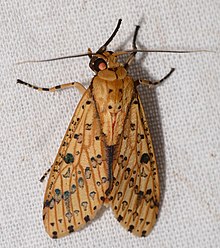| Haemaphlebiella | |
|---|---|
 | |
| Haemaphlebiella strigata | |
| Scientific classification | |
| Domain: | Eukaryota |
| Kingdom: | Animalia |
| Phylum: | Arthropoda |
| Class: | Insecta |
| Order: | Lepidoptera |
| Superfamily: | Noctuoidea |
| Family: | Erebidae |
| Subfamily: | Arctiinae |
| Subtribe: | Phaegopterina |
| Genus: | Haemaphlebiella Collins, 1962 |
| Type species | |
| Baritius venata Rothschild, 1909 | |
| Synonyms | |
| |
Haemaphlebiella is a genus of moths in the family Erebidae. The genus was described by R. J. Collins in 1962. [1] [2]
Contents
Members of this genus are found in the northern part of South America. [3]